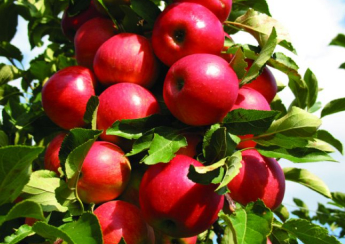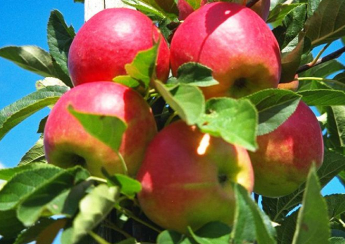APPLES
SLENDER SPINDLE
This is the most used training system for modern apple orchards. The trees are wider at the bottom and get narrower towards the top, which gives them a cone-shaped appearance. The side branches also get shorter further up the top. This system is suitable for low-vigour areas, where the required pruning will not result in exaggerated vegetal expansion. Second-year “knip-booms” are the ideal nursery stock when it comes to planting and growing the crops faster, but well feathered first-year stocks with strong lateral branches are also excellent. Opening the branch angles by weighing down and bending the horizontal branches is necessary during the first 3 to 4 years. Water sprouts and branches which compete with the central axis are to be removed. Renewal pruning will lead to branch renewal. If needed, lowering of the tree height can be achieved by cutting the central axis back to an older branch during the 4th or 5th year.
SUPER SPINDLE
Superspindle represents the most intensive training system. Full production is reached in the 3rd year. At planting time, the trees have a main branch that has side branches with a diameter less than a third of the trunk- this way they do not compete with it. Larger and overlapping branches are to be eliminated. When combined with the correct conditions, such as appropriate soil type, climate, and variety, applying this system results in early bearing and quality and abundant yields, as well as lower costs.
KNIP / KNIP-BOOM
KNIP or “knip-boom” is one of the most productive and best-known apple tree training systems for modern, professional, and industry-grade apple orchards. A KNIP apple tree is produced as a 3-year-old rootstock with a 2-year-old grafted apple variety and 1-year-old side-branches. The shape of a “knip-boom” tree is in the form of the main leader and multiple pre-formed lateral branches going outwards at a high angle, lower branches being longest and branches getting shorter going up the top. The lateral branches are at least 20 cm in length, and the tree itself is 1,5 up to 2,20 m in height.
KNIP trees are produced by bench-grafting the selected apple variety onto selected 1-year-old rootstock and cut back “kniped” after nursing them for 1 full year. When branches start to grow the main leader is formed in the following year, together with cutting the excess lateral branches that overlap or are not going to be productive enough, pinch pruned and treated with phytohormones, all to achieve the recognizable cone shape formation of “knip-boom” tree with side branches on ideal height going outwards at a high angle so that the bending and tying of branches are not necessary. Knipboom trees are classified by the number of fruit-bearing side branches as 3+, 5+, 7+.
KNIP formed apple trees give fruit in the first year after planting (but not significant), and in the following year it is starting to give substantial yields, and up to full yields in the third and fourth year depending on overall conditions and technical measures taken in the apple orchard.
Through modifications of this apple tree training system as a Slender Spindle or a very intensive Superspindle it is possible to obtain full and bigger yields very early, but only together in great accordance with all technical elements of growing apple trees like the spacing of plants in the orchard, climate zone, soil composition, agricultural technical measures, rootstock clone and fruit variety itself.
This system can be tailored to different varieties, but also to different species of fruit. The knipboom system is long proven and adopted the practice in the fruit industry for producing high and early yields and also a long exploitation life of an orchard.

















